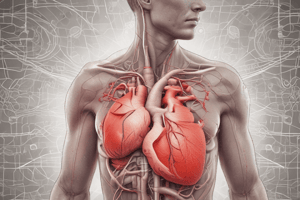Podcast
Questions and Answers
What is the significance of S4 heart sound?
What is the significance of S4 heart sound?
- May be present during pregnancy
- Indicates normal cardiac function
- Indicates volume overload status
- Always pathologic, indicating stiffness of the ventricles (correct)
Which sign is associated with right-sided heart failure?
Which sign is associated with right-sided heart failure?
- Jugular venous distension (correct)
- Weak pulses
- Lightheadedness
- Pulmonary edema
Where is the pulmonic valve best auscultated?
Where is the pulmonic valve best auscultated?
- Right second intercostal space
- Lower left sternal border
- Left second and third intercostal spaces near the sternum (correct)
- At the cardiac apex
What condition is suggested by paroxysmal nocturnal dyspnea?
What condition is suggested by paroxysmal nocturnal dyspnea?
How should S3 be initially assessed with a stethoscope?
How should S3 be initially assessed with a stethoscope?
Flashcards
Heart Sounds (S1 and S2)
Heart Sounds (S1 and S2)
S1 is the closure of tricuspid and mitral valves, marking the start of systole; S2 is the closure of pulmonic and aortic valves, marking the end of systole. Heard using a diaphragm.
Heart Valve Locations
Heart Valve Locations
Aortic valve: right 2nd intercostal space; Pulmonic valve: left 2nd and 3rd intercostal spaces; Tricuspid valve: lower left sternal border; Mitral valve: cardiac apex.
Heart Sounds (S3 and S4)
Heart Sounds (S3 and S4)
S3: often a sign of volume overload, may be normal; S4: always abnormal and suggests ventricular stiffness. Heard using a bell.
Orthopnea/Paroxysmal Nocturnal Dyspnea
Orthopnea/Paroxysmal Nocturnal Dyspnea
Signup and view all the flashcards
Cardiovascular Symptoms
Cardiovascular Symptoms
Signup and view all the flashcards
Study Notes
Heart Sounds and Murmurs
- S1: closure of tricuspid and mitral valves (start of systole)
- S2: closure of pulmonic and aortic valves (end of systole)
- Aortic valve: right 2nd intercostal space or cardiac apex
- Pulmonic valve: left 2nd and 3rd intercostal spaces close to the sternum
- Tricuspid valve: at or near the lower left sternal border
- Mitral valve: at and around the cardiac apex
- Orthopnea: shortness of breath while supine
- Paroxysmal nocturnal dyspnea: waking up from SOB and opening a window to breathe
Heart Valves and Conditions
- S3: volume overload status; not always pathologic (pregnancy)
- S4: stiffness of the ventricles; always pathologic
- Use diaphragm for S1 and S2 for aortic and mitral regurgitation and pericardial friction rubs
- Use bell for S3 and S4 and for murmur of mitral stenosis
- Right sided HF: jugular venous distension (neck bulging), hepatomegaly, peripheral edema, pulmonary hypertension
- Left sided HF: lightheaded, pallor, sweating, hair loss, weak pulses, pulmonary edema
Pulsations and Symptoms
- Carotid pulsations: height of pulsations unchanged by position and not affected by inspiration
- Internal jugular pulsations: height of pulsations changes with position, rarely palpable, height falls with inspiration
- Venous thromboembolism (VTE): includes DVT, PE
- Aortic dissection → ripping chest pain and widened mediastinum
- Urgent!
Studying That Suits You
Use AI to generate personalized quizzes and flashcards to suit your learning preferences.




